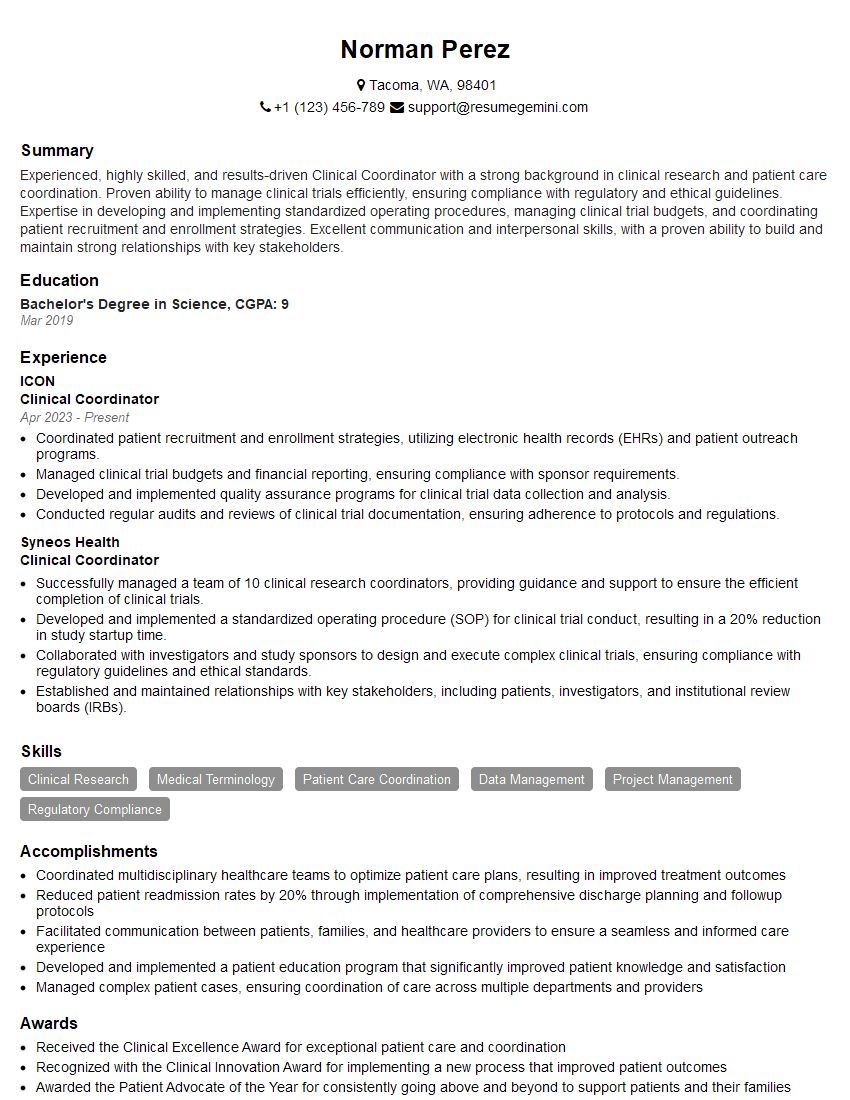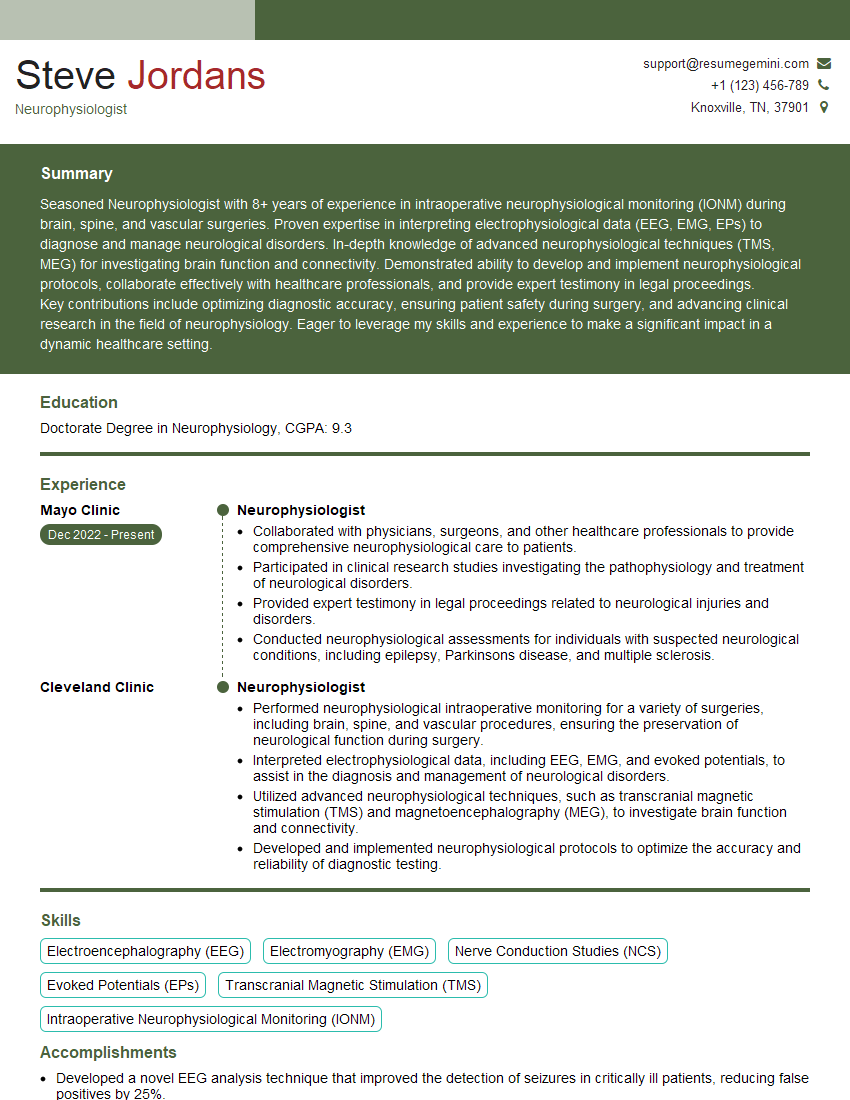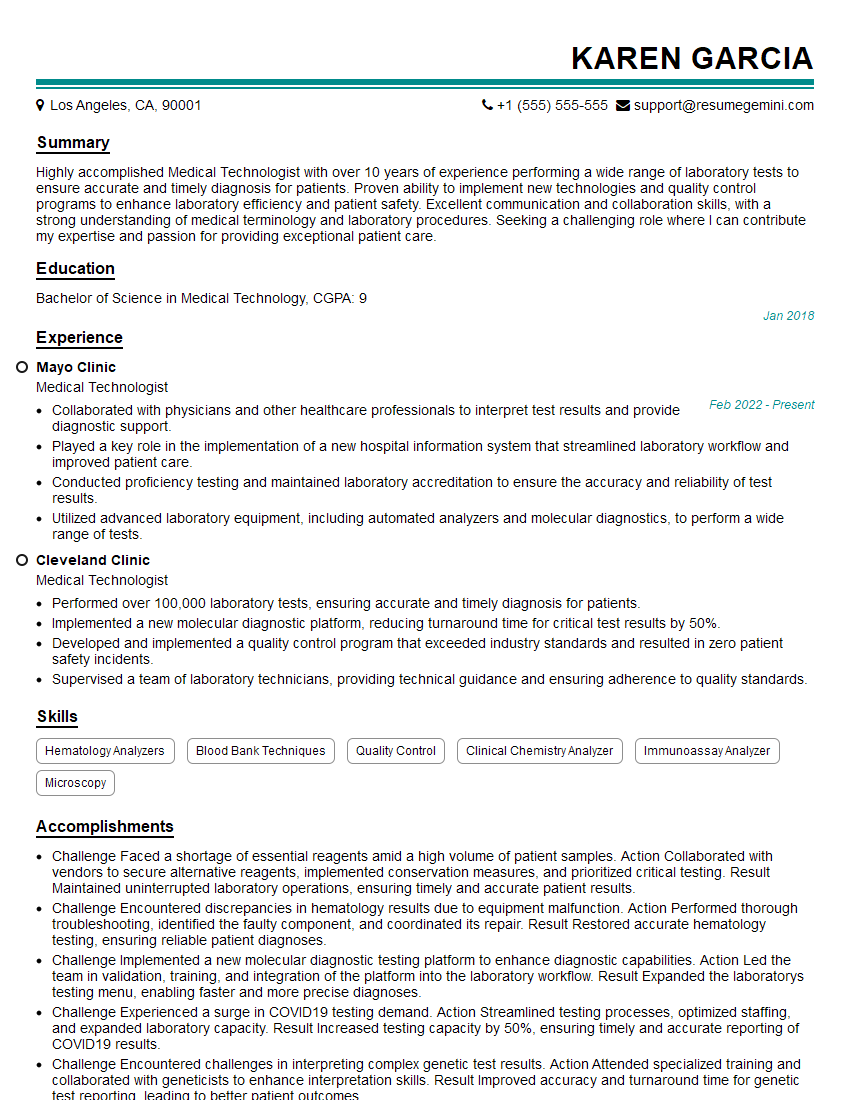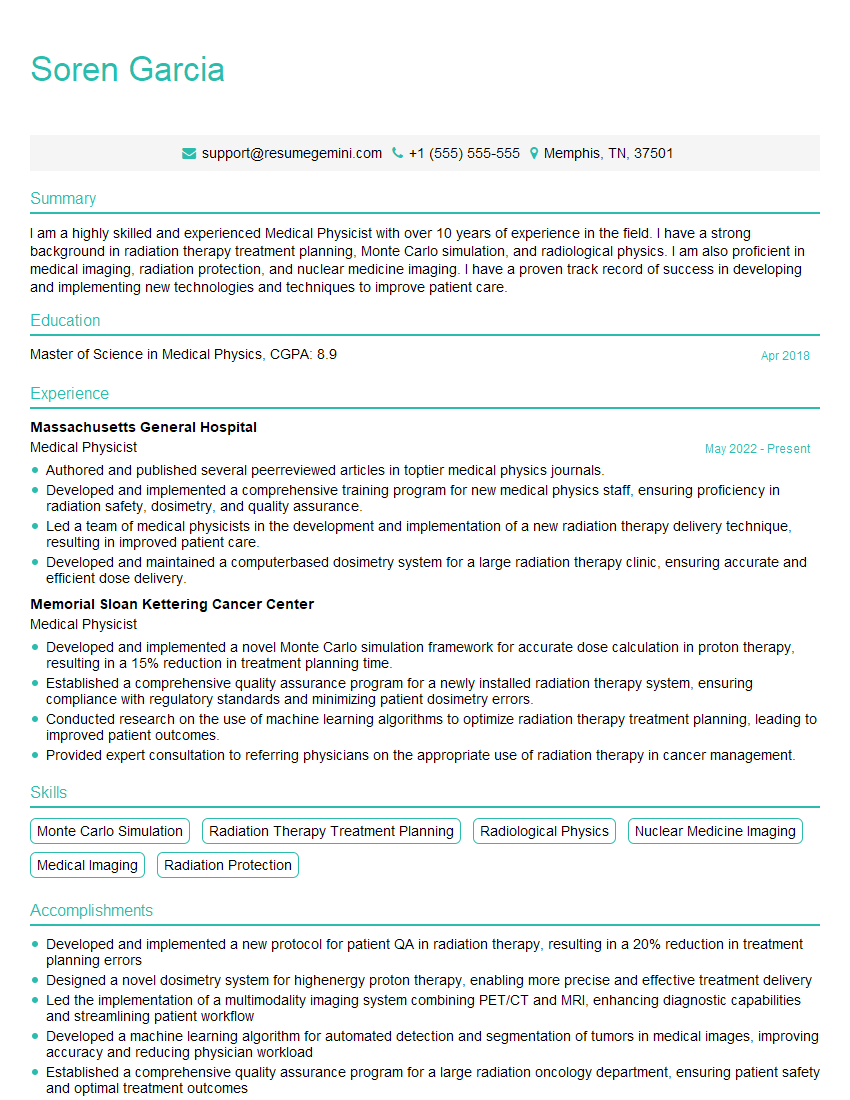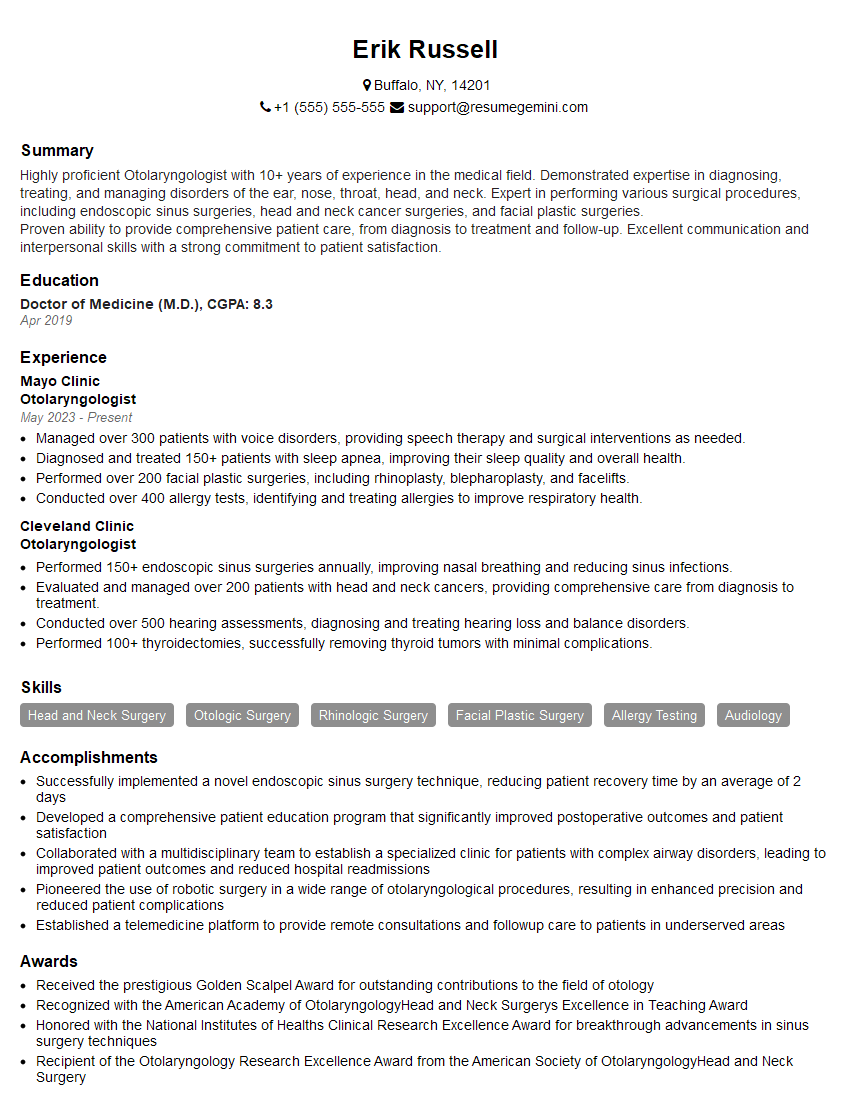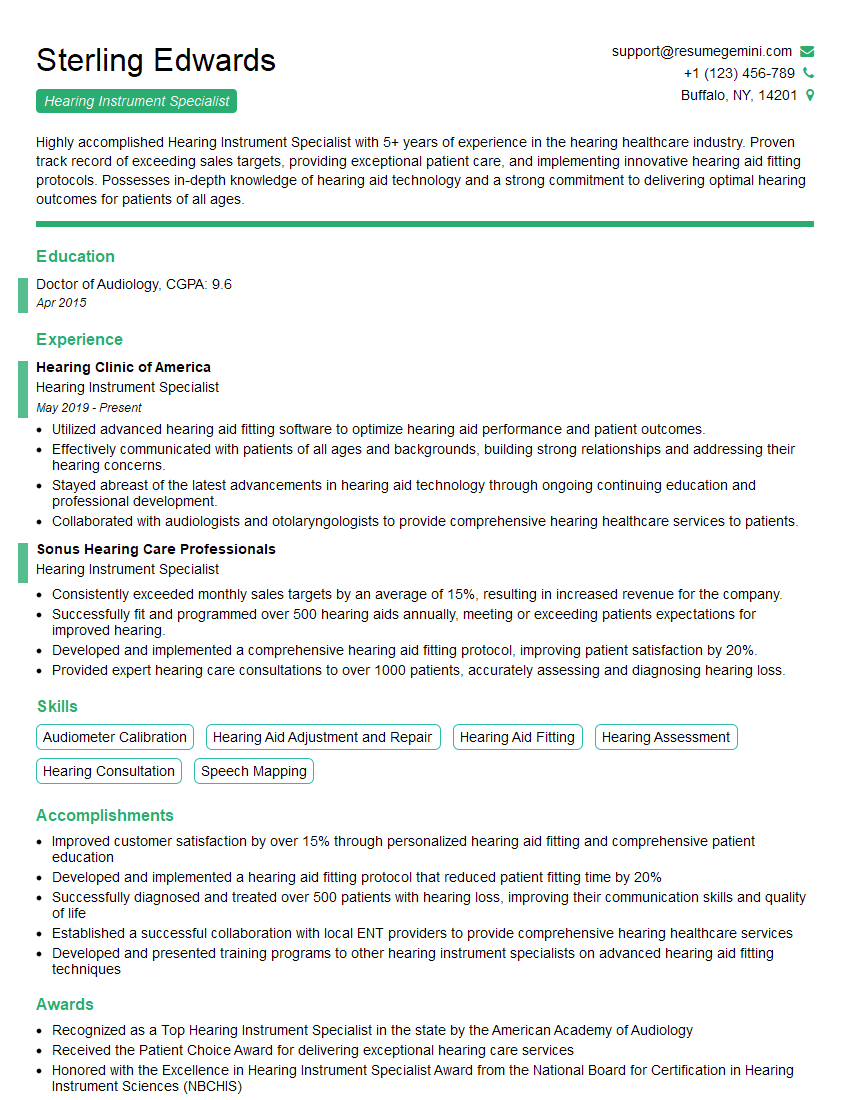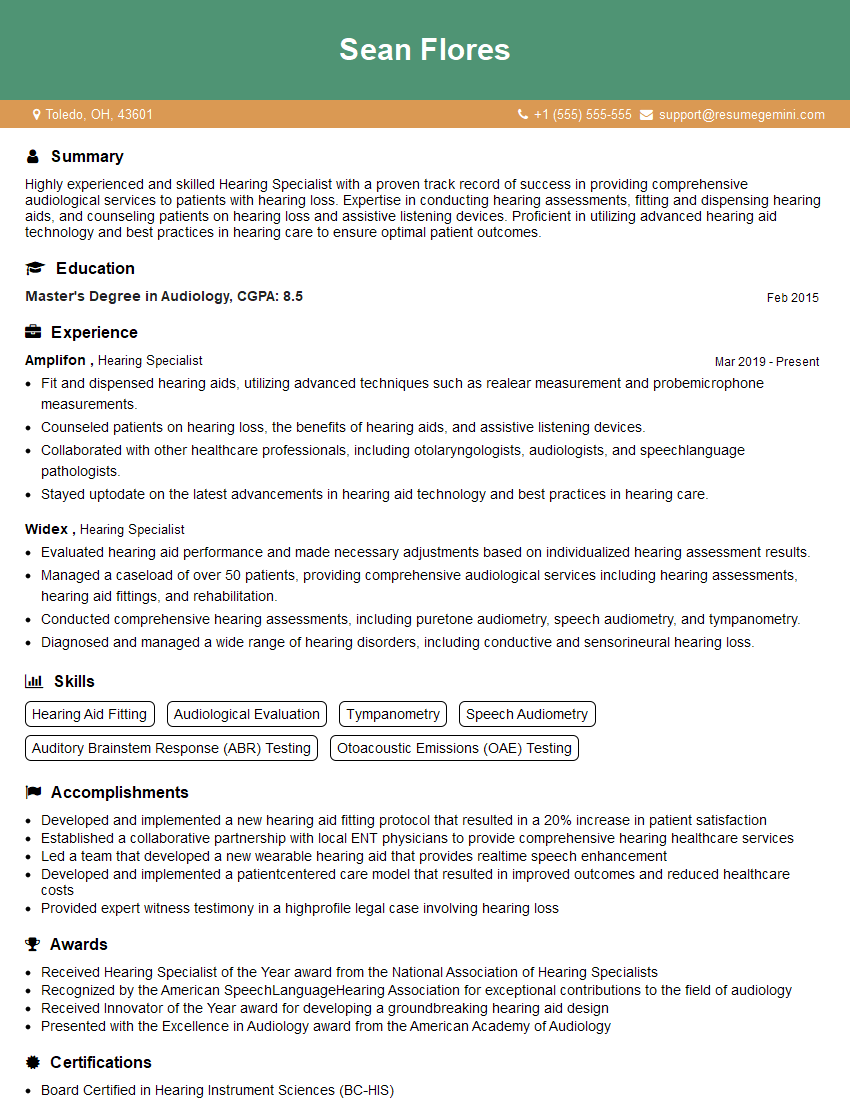Cracking a skill-specific interview, like one for Auditory Brainstem Response Testing, requires understanding the nuances of the role. In this blog, we present the questions you’re most likely to encounter, along with insights into how to answer them effectively. Let’s ensure you’re ready to make a strong impression.
Questions Asked in Auditory Brainstem Response Testing Interview
Q 1. Describe the principles behind Auditory Brainstem Response (ABR) testing.
Auditory Brainstem Response (ABR) testing is a neurophysiological test that measures the electrical activity of the auditory pathway in the brainstem in response to auditory stimuli. It relies on the principle of recording these extremely small electrical responses using surface electrodes. These responses are generated by the brainstem’s response to sound, with different waves representing activity at various stages along the auditory pathway. The test is highly sensitive to detecting subtle abnormalities that might be missed by other hearing tests.
Imagine a tiny microphone inside the brain, picking up the electrical signals produced when sound travels through the auditory system. ABR testing amplifies these faint signals and presents them as a waveform, providing a window into the health of this crucial pathway.
Q 2. Explain the different waveforms observed in an ABR recording and their clinical significance.
A typical ABR waveform consists of several peaks, labeled as waves I through VII, though waves I-V are most commonly observed and clinically relevant. Each wave represents activity at a specific location within the auditory pathway.
- Wave I: Represents activity in the auditory nerve (VIIIth cranial nerve).
- Wave II: Represents activity in the cochlear nucleus.
- Wave III: Represents activity in the superior olivary complex.
- Wave IV: Represents activity from both the superior olivary complex and the lateral lemniscus.
- Wave V: Represents activity in the inferior colliculus.
Clinically, the latency (time it takes for the wave to appear) and amplitude (height) of each wave are crucial. Abnormal latencies suggest delays in neural transmission, potentially indicating a lesion or pathology along the auditory pathway. Reduced amplitudes may signify reduced neural function or damage. For example, a significantly prolonged latency of wave I might suggest damage to the auditory nerve, while absent waves suggest significant pathology.
Q 3. What are the common clinical applications of ABR testing?
ABR testing has a wide array of clinical applications, primarily focused on assessing the integrity of the auditory pathway. Some key applications include:
- Neonatal hearing screening: ABR is a crucial tool for detecting hearing loss in newborns, often used as part of universal newborn hearing screening programs.
- Diagnosis of auditory neuropathies: ABR helps identify problems within the auditory nerve itself, differentiating it from other causes of hearing loss.
- Assessment of brainstem lesions: ABR can help locate and diagnose lesions affecting the brainstem, such as tumors or multiple sclerosis.
- Monitoring of auditory function during surgery: Intraoperative ABR monitoring can be used during surgeries near the brainstem to ensure the auditory pathway remains intact.
- Objective assessment of hearing thresholds: While not as precise as behavioral audiometry in older children and adults, it can provide a reliable estimation of hearing thresholds, particularly in difficult-to-test populations.
Q 4. How do you interpret an ABR recording with absent or delayed waves?
Absent or delayed waves on an ABR recording indicate dysfunction or damage along the auditory pathway. The interpretation requires careful consideration of which waves are affected and the degree of abnormality.
Absent waves: suggest significant damage at or before the neural generator of that wave. For instance, an absent wave I strongly suggests significant auditory nerve damage. An absent wave V might indicate a lesion at the level of the inferior colliculus.
Delayed waves: suggest slowed neural transmission, often caused by demyelinating diseases (e.g., multiple sclerosis), tumors, or other lesions that affect the speed of signal conduction. The specific wave affected helps to localize the area of the problem. For example, prolonged latency of wave I-III may suggest a problem involving the auditory nerve, cochlear nucleus and superior olivary complex.
A thorough clinical evaluation integrating ABR findings with other test results (such as behavioral audiometry, MRI) is crucial for accurate diagnosis.
Q 5. Discuss the different types of electrodes used in ABR testing and their placement.
Several types of electrodes are used in ABR testing, with the choice depending on factors like patient age and testing environment. The goal is to obtain high-quality recordings with minimal artifact.
- Needle electrodes: Often used in newborns and infants, these are small needles inserted subdermally near the earlobe or mastoid.
- Surface electrodes: These are small, adhesive electrodes placed on the scalp at specific locations. Commonly used in older children and adults, they offer greater comfort and are easier to apply.
- Vertex electrode: A surface electrode placed at the vertex (top) of the head. Often used as a reference electrode.
Placement: Electrode placement is crucial for optimal recordings. Typically, electrodes are placed on the mastoid processes (bony prominences behind the ears) or the earlobes, serving as recording electrodes. A reference electrode is often placed at the vertex. Precise placement is crucial to minimize noise and improve signal clarity.
Q 6. Explain the importance of proper electrode impedance in ABR recordings.
Proper electrode impedance is critical for obtaining high-quality ABR recordings. Impedance refers to the resistance to the flow of electrical current. High impedance values (typically above 5kOhms) can lead to poor signal quality, resulting in noisy recordings with reduced amplitude and distorted waveforms making it harder to identify waves reliably.
Low impedance values (ideally below 5kOhms) facilitate better signal transmission, allowing for clearer waveforms and improved signal-to-noise ratio. Before commencing the test, it’s essential to ensure that the impedance is within the acceptable range. This involves cleaning the skin, applying conductive gel, and adjusting electrode placement as needed.
Q 7. How do you identify and mitigate artifacts in ABR recordings?
Artifacts in ABR recordings are unwanted signals that contaminate the true ABR waveforms. These can significantly compromise the test’s accuracy and interpretation. Common artifacts include:
- Muscle activity: Patient movement, especially during testing can introduce muscle potentials that look similar to ABR waves leading to misinterpretations.
- Electrode noise: Poor electrode contact, high impedance, or loose connections can introduce noise into the recordings.
- Environmental noise: External electrical interference, such as from nearby equipment, can also contaminate ABR signals.
Mitigation strategies: Identifying and mitigating artifacts is vital. Strategies include ensuring patient comfort and immobility (e.g., sedation in infants), optimizing electrode placement and impedance, using appropriate shielding to minimize electrical interference, and carefully reviewing the recordings for any clear artifacts. Averaging multiple sweeps of the recording helps to reduce random noise and enhances the signal-to-noise ratio. In cases where artifacts are excessive, the test might need to be repeated.
Q 8. Describe the procedure for performing an ABR test on an adult patient.
Performing an ABR test on an adult is relatively straightforward. First, the patient is comfortably seated or reclined in a sound-attenuating booth to minimize external noise interference. Electrodes are placed on the patient’s scalp: a ground electrode, typically on the forehead, and recording electrodes on the mastoid processes (behind the ears) and vertex (top of the head). These electrodes detect the tiny electrical responses generated by the auditory brainstem. Next, click stimuli or tone bursts, of varying intensities and frequencies, are delivered through earphones. The ABR signals, which are very small, are amplified, filtered and averaged across many stimulus presentations to improve the signal-to-noise ratio. This averaged waveform reveals a series of characteristic peaks (Waves I-V) representing the activity of various structures along the auditory pathway. The latency (time) and amplitude (size) of these waves are then measured and analyzed to assess the integrity of the auditory pathways.
Think of it like listening to a faint whisper in a noisy room. The averaging process helps us ‘hear’ the whisper amidst the background noise. The peaks on the ABR waveform are analogous to this whisper – they reveal the subtle activity in the auditory system.
Q 9. How do you adjust ABR testing parameters for infants and children?
Testing infants and children requires modifications due to their developmental stage and shorter attention spans. For infants, the test often needs to be performed while they are sleeping or sedated to minimize movement artifacts, which can contaminate the recordings. Stimulus parameters, such as intensity and frequency, are typically adjusted to match the child’s hearing capabilities and developmental stage. For example, younger infants might require higher intensity stimuli. Shorter interstimulus intervals (the time between stimuli) might be used to maintain alertness or to accommodate the shorter attention spans. The use of age-appropriate and engaging visual stimuli during the recording can also be helpful in keeping young children still. The interpretation of ABR results in children also takes into account age-related normative data.
For example, a six-month-old might show slightly different wave latencies than a three-year-old, even with normal hearing. This is because neural conduction speeds mature over time.
Q 10. What are the limitations of ABR testing?
ABR testing, while a valuable diagnostic tool, has limitations. Firstly, it primarily assesses the brainstem portion of the auditory pathway; it doesn’t provide information about the higher auditory centers responsible for sound perception and interpretation. A normal ABR doesn’t guarantee normal hearing perception. Secondly, factors like sedation, patient movement, and background noise can affect the quality of the recordings and the reliability of results. Thirdly, ABR interpretation can be challenging in the presence of certain neurological conditions that affect the brainstem. Finally, ABR is not a precise measure of hearing thresholds, making it less accurate for the assessment of mild hearing losses.
Imagine ABR as a snapshot of a specific portion of the auditory pathway. While it gives crucial information, a complete understanding of hearing requires a broader assessment.
Q 11. How do you differentiate between conductive and sensorineural hearing loss using ABR?
ABR helps differentiate between conductive and sensorineural hearing loss by assessing the presence and amplitude of the ABR waves. In conductive hearing loss, sound transmission to the inner ear is impaired (e.g., due to middle ear fluid or blockage). This results in a reduction in the amplitude of the ABR waves but does not significantly affect wave latencies. In sensorineural hearing loss, there is damage to the inner ear or auditory nerve. This leads to both a reduction in amplitude and an increase in the latencies of the ABR waves. By comparing the ABR findings with other audiological tests, like pure-tone audiometry, a more precise diagnosis can be made.
Think of it like a leaky faucet (conductive) versus a broken pipe (sensorineural). The leaky faucet reduces the water pressure (amplitude), while the broken pipe reduces pressure and also delays the water flow (latency).
Q 12. Discuss the role of ABR in the diagnosis of auditory neuropathy spectrum disorder (ANSD).
Auditory Neuropathy Spectrum Disorder (ANSD) is characterized by normal or near-normal ABR results despite significant hearing impairment. This paradoxical finding highlights the diagnostic challenge of ANSD. In ANSD, the auditory nerve may have structural integrity, but it lacks the ability to transmit signals effectively to the brainstem. Therefore, ABR waves are present, but their morphology may be abnormal and the patient’s hearing is poor. ABR is a key part of the diagnostic process for ANSD as it helps distinguish it from other types of hearing loss where ABR abnormalities are expected. Further testing, like distortion product otoacoustic emissions (DPOAE), is often used in conjunction with ABR to confirm the diagnosis.
In essence, ABR in ANSD helps to identify that the problem lies not in the basic neural conduction up the auditory pathway, but in the way that information is encoded and transmitted by the auditory nerve.
Q 13. Explain how ABR results are used to monitor the progress of patients with auditory pathologies.
Serial ABR testing is valuable for monitoring the progression of auditory pathologies. For example, in cases of acoustic neuroma (a tumor on the auditory nerve), repeat ABRs can show changes in wave latencies or amplitudes, reflecting tumor growth or response to treatment. Similarly, ABRs can be used to assess the effectiveness of interventions in patients with other auditory disorders. By comparing ABR results obtained over time, clinicians can evaluate disease progression and the impact of treatment strategies. A change in wave latencies or amplitudes could signal worsening or improvement in the condition. This allows for timely adjustments in the management plan.
Imagine ABR as a tracking device that monitors the health of the auditory pathway. Consistent monitoring helps to ensure the patient receives appropriate care.
Q 14. What are the safety precautions you need to take while performing ABR testing?
Safety precautions during ABR testing are paramount. The most significant aspect is the proper placement of electrodes to ensure accurate recording and to prevent skin irritation or damage. It is essential to use sterile techniques when preparing the skin. Furthermore, the intensity of the auditory stimuli should be kept below levels that might cause discomfort or hearing damage. Regular checks on the equipment are crucial to ensure optimal performance and prevent malfunctions. Proper grounding of the equipment is essential to minimize the risk of electrical shock. Finally, for pediatric patients, careful consideration must be given to minimize stress and potential discomfort. This may include the use of sedation or other calming techniques.
Prioritizing safety is crucial to ensure patient comfort and reliable testing results, preventing both physical and emotional harm during the procedure.
Q 15. How do you ensure the quality and reliability of ABR recordings?
Ensuring the quality and reliability of ABR recordings is crucial for accurate diagnosis. This involves meticulous attention to detail throughout the entire process, from patient preparation to data analysis. We employ several strategies:
- Proper Patient Preparation: This includes ensuring the patient is comfortable and relaxed to minimize movement artifacts. For infants, we ensure they are adequately sedated or asleep to eliminate movement. We also control for environmental noise.
- Equipment Calibration and Maintenance: Regularly scheduled calibrations of the ABR system using standardized acoustic signals are essential. This ensures accurate stimulus delivery and signal amplification.
- Electrode Placement and Impedance: Correct electrode placement (typically at the vertex, mastoid, and forehead) is vital. We meticulously check electrode impedance to ensure good signal transmission and minimize artifact. High impedance readings indicate a poor connection and could result in noisy recordings.
- Artifact Rejection: Movement artifacts are a common problem. Sophisticated software allows for the identification and rejection of these artifacts, ensuring only clean data is analyzed. Visual inspection of the raw data is also crucial.
- Averaging: The ABR signal is extremely small, so we use averaging techniques to improve the signal-to-noise ratio. More sweeps (repetitions of the stimulus) lead to a clearer waveform.
- Experienced Interpretation: Finally, proper interpretation requires significant experience and expertise. Knowing the normal variations in ABR latencies and amplitudes is essential for differentiating normal findings from pathologic ones. For example, a subtle wave V latency delay might be indicative of mild hearing loss, while a more significant delay or absence of waves might suggest a severe problem.
Career Expert Tips:
- Ace those interviews! Prepare effectively by reviewing the Top 50 Most Common Interview Questions on ResumeGemini.
- Navigate your job search with confidence! Explore a wide range of Career Tips on ResumeGemini. Learn about common challenges and recommendations to overcome them.
- Craft the perfect resume! Master the Art of Resume Writing with ResumeGemini’s guide. Showcase your unique qualifications and achievements effectively.
- Don’t miss out on holiday savings! Build your dream resume with ResumeGemini’s ATS optimized templates.
Q 16. Describe the process of calibrating ABR equipment.
Calibrating ABR equipment is a critical step to guarantee accurate results. It involves verifying the intensity and timing of the auditory stimulus as well as the amplification and filtering of the recorded electrical potentials.
The process typically involves:
- Acoustic Calibration: This verifies the sound level (intensity) and frequency of the clicks or tone bursts generated by the system. We use a calibrated sound level meter to check that the output matches the intended values. Any discrepancies need adjustment through the equipment’s internal controls.
- Electrical Calibration: This confirms the proper function of the amplifiers, filters, and analog-to-digital converters. We might use known test signals to verify the system’s linearity and gain.
- System Check: Performing a complete system check ensures all components of the ABR system (stimuli generators, amplifiers, filters, A/D converters, and recording software) are functioning optimally. This includes checking the grounding and shielding to reduce interference.
- Record Keeping: Maintaining detailed records of all calibration procedures and findings is essential for quality assurance and troubleshooting.
Regular calibration, ideally daily or weekly, is crucial to maintain the accuracy and reliability of ABR recordings. Failure to calibrate could result in misinterpretations of the data, leading to inaccurate diagnoses.
Q 17. What are the different types of ABR stimulus used?
Several types of stimuli are used in ABR testing, each with its own advantages and disadvantages:
- Click Stimuli: These are brief, broadband clicks that activate a wide range of frequencies in the cochlea. They’re easy to generate and widely used, especially for screening purposes. However, they provide less frequency-specific information than other stimuli.
- Tone Bursts: These are brief bursts of pure tones, allowing for frequency-specific assessment of hearing. Different frequencies can be tested to map the audiogram more accurately. The analysis is more complex, though.
- Chirps: Chirps are frequency-modulated stimuli that cover a wide range of frequencies within a short duration. They offer good temporal resolution and can provide valuable information in cases where conventional click stimuli might be problematic (e.g., in patients with auditory neuropathy spectrum disorder).
The choice of stimulus depends on the clinical question. For a basic hearing screening, clicks are often sufficient. For detailed evaluation of specific frequency regions, tone bursts are preferred. Chirps are increasingly used for assessing more subtle auditory processing deficits.
Q 18. What is the typical latency range for each wave in an ABR recording?
The typical latency range for each wave in an ABR recording varies slightly depending on factors like age, stimulus type, and recording parameters, but approximate values are:
- Wave I: 1.5-2.5 milliseconds (ms) – Reflects activity in the auditory nerve.
- Wave II: 2.5-4.0 ms – Reflects activity in the cochlear nucleus.
- Wave III: 3.5-5.5 ms – Reflects activity in the superior olivary complex.
- Wave IV: 4.5-6.5 ms – A complex wave with contributions from various brainstem nuclei.
- Wave V: 5.5-7.5 ms – Reflects activity in the lateral lemniscus and inferior colliculus. This is usually the most prominent wave.
Significant deviations from these latencies can indicate neurological or auditory pathology.
Q 19. How does age affect ABR latencies and amplitudes?
Age significantly influences ABR latencies and amplitudes. As we age, neural conduction velocity tends to decrease, leading to increased latencies. Amplitudes may also decrease.
In Infants: ABR latencies are generally longer in newborns and young infants compared to adults, gradually decreasing with age. Amplitudes may also be lower due to the immaturity of the auditory system.
In Older Adults: In older adults, the typical pattern is slightly prolonged latencies and decreased amplitudes for all waves. This is part of the normal aging process but can make it more challenging to differentiate age-related changes from pathological conditions. Accurate interpretation requires considering the patient’s age and comparing the results to age-appropriate normative data.
Q 20. Explain the difference between absolute and interpeak latencies.
Both absolute and interpeak latencies are important measures in ABR interpretation, but they provide different types of information:
- Absolute Latencies: These refer to the time elapsed from the onset of the stimulus to the peak of each individual wave (e.g., the latency of Wave V). They reflect the overall conduction time from the auditory periphery to the brainstem nuclei involved in generating that specific wave.
- Interpeak Latencies: These represent the time difference between the peaks of two consecutive waves (e.g., the latency between Wave I and Wave V, or I-V interpeak latency). They provide a measure of the conduction time between specific brainstem nuclei and are often more sensitive to detecting abnormalities than absolute latencies alone. For instance, a prolonged I-V interpeak latency might suggest a problem in the auditory pathway between the auditory nerve and the inferior colliculus.
Both absolute and interpeak latencies are used together to build a comprehensive picture of auditory brainstem function. One should not be interpreted without the other.
Q 21. Describe the effects of different types of hearing loss on ABR waveforms.
Different types of hearing loss manifest differently on ABR waveforms:
- Sensorineural Hearing Loss: This involves damage to the inner ear (cochlea) or auditory nerve. ABR findings usually show increased latencies and decreased amplitudes, especially in Wave I. The degree of change correlates with the severity of the hearing loss. The higher-frequency waves may also be affected, depending on the extent of neural damage.
- Conductive Hearing Loss: This is caused by problems in the outer or middle ear, impeding sound transmission to the inner ear. In conductive hearing loss, ABR waveforms are often normal, though the amplitudes may be slightly reduced if the loss is severe, because the stimulus intensity needs to be higher to overcome the conductive impairment.
- Auditory Neuropathy Spectrum Disorder (ANSD): This condition involves problems with the transmission of neural signals from the cochlea to the brainstem, despite normal or near-normal cochlear function. Individuals with ANSD may have normal or near-normal wave I latencies, but reduced or absent later waves (III and V), indicating impaired signal transmission at the level of the brainstem.
Careful analysis of both latencies and amplitudes across all waves helps differentiate among different types of hearing loss and identify underlying pathology. For example, a patient with significant delays in the later waves but relatively normal Wave I latency might have ANSD instead of sensorineural hearing loss.
Q 22. How do you interpret ABR findings in patients with brainstem lesions?
Interpreting ABR findings in patients with brainstem lesions involves carefully examining wave morphology and latencies. A normal ABR shows five distinct waves (I-V) representing neural activity at different points along the auditory pathway. Brainstem lesions can cause a variety of abnormalities. For example, a lesion affecting the cochlear nucleus might result in an absent or severely reduced Wave I. A lesion in the pons could affect Waves III and V, leading to prolonged interpeak latencies (e.g., prolonged I-III or III-V intervals) or absent waves. The absence of later waves (IV and V) could point to a more severe lesion or one affecting the midbrain. The specific pattern of abnormalities helps localize the lesion within the brainstem. It is crucial to remember that interpretation shouldn’t be done in isolation; clinical history, neuroimaging results, and other neurological findings must be considered for a comprehensive diagnosis.
Example: A patient presenting with hearing loss and suspected multiple sclerosis might show prolonged I-III and III-V interpeak latencies on ABR, suggesting demyelination affecting the brainstem auditory pathways. This finding, combined with MRI evidence of demyelination, would support the diagnosis.
Q 23. How do you handle situations with poor ABR recordings due to patient movement or artifacts?
Poor ABR recordings due to artifacts are a common challenge. Patient movement creates noise and obscures the subtle waves. My approach involves a multi-pronged strategy. First, I optimize recording parameters like electrode placement to minimize artifacts. Second, I use artifact rejection software to automatically remove epochs contaminated by excessive noise. This involves setting thresholds for acceptable voltage fluctuations. For particularly challenging cases, I employ averaging techniques; by averaging many trials, the random noise tends to cancel itself out, while the true ABR signal, consistent across trials, is amplified.
If artifacts persist despite these efforts, I might consider repeating the test with measures to improve patient comfort and reduce movement. This could include sedation (under medical supervision) for younger children or anxious adults, or using more secure electrode placement techniques. Documenting the artifacts and their effect on the interpretation is always critical.
Q 24. What are the potential risks and side effects of ABR testing?
ABR testing is generally considered safe. Potential risks are minimal and primarily related to electrode placement. These include minor skin irritation or discomfort at the electrode sites. In rare cases, allergic reactions to the electrode gel might occur. It’s crucial to use hypoallergenic gels and monitor the patient for any adverse reactions.
The procedure itself is painless; however, infant and young children might be distressed by the sound stimuli. This is usually mitigated by using appropriate sound levels and providing comfort measures. More serious complications are extremely rare and usually associated with underlying medical conditions or procedural errors.
Q 25. Discuss the advantages and disadvantages of ABR compared to other auditory evoked potential tests.
ABR offers several advantages over other auditory evoked potentials (AEPs) like middle-latency responses (MLRs) or late auditory evoked potentials (LAEPs). ABR’s main strength lies in its high temporal resolution, allowing for precise localization of brainstem lesions. It is less susceptible to the influence of attention and cognitive state than MLRs and LAEPs. This makes it particularly valuable in assessing newborns and patients who are unable to cooperate fully.
However, ABR has limitations. It primarily assesses the brainstem pathway; it doesn’t provide information about higher-level auditory processing functions evaluated by MLRs or LAEPs. ABR is also more technically challenging, requiring specialized equipment and expertise. Wave identification can be subjective, especially in cases with poor quality recordings.
Q 26. How do you explain ABR results to patients and their families?
Explaining ABR results requires careful communication tailored to the patient’s understanding. I avoid overly technical jargon. For example, instead of saying “prolonged interpeak latencies,” I might explain that the test shows “some delays in the signals traveling through the brainstem’s hearing pathways.”
I use clear and simple analogies to illustrate concepts. For example, comparing the ABR waves to signals traveling along an electrical wire helps visualize the pathway. I present the results in a positive and reassuring manner, emphasizing that the test provides valuable information for diagnosis and treatment planning. The specific details shared depend on the findings and their clinical significance. In cases of abnormal results, I clearly explain the implications without creating unnecessary alarm.
Q 27. What are the ethical considerations in ABR testing?
Ethical considerations in ABR testing center on informed consent, patient confidentiality, and appropriate use of the test. Informed consent means ensuring that the patient or their guardian fully understands the purpose, procedure, risks, and benefits of the test before proceeding. Confidentiality is maintained by protecting the patient’s medical information. The test should only be ordered when clinically indicated, minimizing unnecessary exposure to sound stimuli. In cases involving children, parental consent and the child’s well-being are paramount.
Furthermore, appropriate interpretation and reporting of results are crucial to avoid misdiagnosis or unnecessary treatment. Interpretations should always be within the examiner’s area of expertise.
Q 28. Describe your experience with different ABR software and analysis systems.
Throughout my career, I’ve worked with various ABR software and analysis systems, including commercially available packages like [mention specific examples e.g., NeuroScan, Bio-logic] and custom-developed systems within research settings. My experience spans different platforms and operating systems. I’m proficient in using these systems to acquire, process, and analyze ABR data, including artifact rejection, wave identification (manual and automated), latency and amplitude measurements, and report generation. The key differences among these systems often lie in their user interface, artifact rejection algorithms, and advanced analysis features. The choice of system often depends on the specific clinical needs and research questions.
I also possess experience in troubleshooting technical issues with these systems, ensuring accurate and reliable data acquisition and analysis. This includes recognizing and addressing issues related to electrode impedance, noise, and software malfunctions.
Key Topics to Learn for Auditory Brainstem Response Testing Interview
- Waveform Morphology: Understand the characteristics of each wave (I-V), their latencies, and amplitudes. Be prepared to discuss variations and their clinical significance.
- Stimulus Parameters: Master the different types of stimuli used (click, tone burst), their intensity levels, and how these affect the ABR waveform. Explain the rationale behind choosing specific parameters for different patient populations.
- Instrumentation and Equipment: Demonstrate familiarity with ABR equipment, including the electrophysiological recording system, electrodes, and impedance monitoring. Be ready to discuss troubleshooting common issues.
- Interpretation of Results: Practice interpreting ABR waveforms. Understand how to identify normal and abnormal findings, and be prepared to discuss the clinical implications of different patterns.
- Clinical Applications: Discuss the use of ABR testing in various clinical scenarios, such as newborn hearing screening, assessment of auditory neuropathy, and the diagnosis of brainstem lesions.
- Artifacts and Noise Reduction: Explain common sources of artifacts in ABR recordings (e.g., muscle activity, electrical interference) and techniques for minimizing their impact.
- Test Limitations and Contraindications: Understand the limitations of ABR testing and when it may not be appropriate to use this technique. Be familiar with potential contraindications.
- Ethical Considerations: Discuss patient safety and confidentiality, appropriate use of technology, and informed consent procedures within the context of ABR testing.
Next Steps
Mastering Auditory Brainstem Response Testing opens doors to rewarding careers in audiology and related fields. A strong understanding of this crucial diagnostic tool is highly valued by employers. To maximize your job prospects, invest in creating an ATS-friendly resume that showcases your skills and experience effectively. ResumeGemini is a trusted resource that can help you build a professional and impactful resume, ensuring your qualifications stand out. They offer examples of resumes tailored specifically to Auditory Brainstem Response Testing professionals, providing a valuable template for your own application materials. Take the next step toward your dream career—build a winning resume today.
Explore more articles
Users Rating of Our Blogs
Share Your Experience
We value your feedback! Please rate our content and share your thoughts (optional).
What Readers Say About Our Blog
This was kind of a unique content I found around the specialized skills. Very helpful questions and good detailed answers.
Very Helpful blog, thank you Interviewgemini team.


